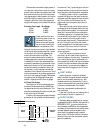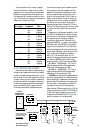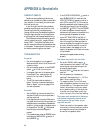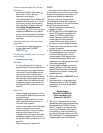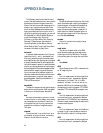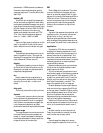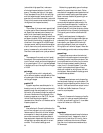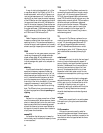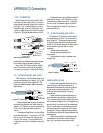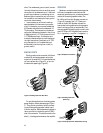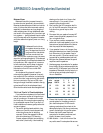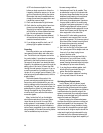29
referenced to 1 VRMS across any impedance.
Commonly used to describe signal levels in
consumer equipment. To convert dBV to dBu,
add 2.2 dB.
decibel (dB)
The dB is a ratio of quantities measured in
similar terms using a logarithmic scale. Many
audio system parameters measure over such a
large range of values that the dB is used to sim-
plify the numbers. A ratio of 1000V:1V=60 dB.
When one of the terms in the ratio is an
agreed-upon standard value such as 0.775V,
1V, or 1mw, the ratio becomes an absolute
value, i.e., +4 dBu, –10dBV, or 0 dBM.
detent
A point of slight physical resistance (a click-
stop) in the travel of a knob or slide control,
used in Mackie mixers to indicate unity gain.
diffraction
The bending of sound waves around an ob-
stacle (Huygens Principle). The longer the
wavelength in comparison to the obstacle, the
more the wave will diffract around it.
dipping
The opposite of peaking, of course. A dip is
an EQ curve that looks like a valley, or a dip.
Dipping with an equalizer reduces a band of
frequencies. See guacamole.
dry
Usually means without reverberation, or
without some other applied effect like delay or
chorusing. Dry is not wet, i.e. totally unaf-
fected.
duty cycle
The ratio of pulse width to total cycle time.
dynamic
In sound work, dynamic refers to the class
of microphones that generates electrical sig-
nals by the movement of a coil in a magnetic
field. Dynamic microphones are rugged, rela-
tively inexpensive, capable of very good
performance and do not require external power.
dynamic range
The range between the maximum and mini-
mum sound levels that a sound system can
handle. It is usually expressed in decibels as
the difference between the level at peak clip-
ping and the level of the noise floor.
EMI
Electro Magnetic Interference. This refers
to current induced into the signal path as a
result of an external magnetic field. In audio
systems, this is usually manifested as a 60Hz or
120Hz hum or buzz. The source of this noise
can be from a ground loop or from the signal
wire coming too close to a strong magnetic
field such as a transformer or high-current
linecord.
EQ curve
A graph of the response of an equalizer, with
frequency on the x (horizontal) axis and am-
plitude (level) on the y (vertical) axis.
Equalizer types and effects are often named
after the shape of the graphed response curve,
such as peak, dip, shelf, notch, knee, and so on.
equalization
Equalization (EQ) refers to purposefully
changing the frequency response of a circuit,
sometimes to correct for previous unequal re-
sponse (hence the term, equalization), and
more often to add or subtract level at certain
frequencies for sound enhancement, to remove
extraneous sounds, or to create completely
new and different sounds.
Bass and treble controls on your stereo are
EQ; so are the units called parametrics and
graphics and notch filters.
A lot of how we refer to equalization has to
do with what a graph of the frequency response
would look like. A flat response (no EQ) is a
straight line, a peak looks like a hill, a dip is a
valley, a notch is a really skinny valley, and a
shelf looks like a plateau (or a shelf). The
slope is the grade of the hill on the graph.
Graphic equalizers have enough frequency
slider controls to form a graph of the EQ right
on the front panel. Parametric EQs let you vary
several EQ parameters at once. A filter is sim-
ply a form of equalizer that allows certain
frequencies through unmolested while reduc-
ing or eliminating other frequencies.
Aside from the level controls, EQs are prob-
ably the second most powerful controls on any
mixer (no, the power switch doesn’t count!).
fader
Another name for an audio level control.
Today, the term refers to a straight-line slide
control rather than a rotary control.
filter
A simple equalizer designed to remove
certain ranges of frequencies. A low-cut filter






